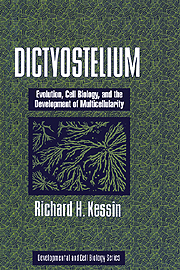Book contents
- Frontmatter
- Contents
- Preface
- 1 A Brief Introduction to Dictyostelium discoideum and its Relatives
- 2 A History of Research on Dictyostelium discoideum
- 3 The Evolutionary Biology of Dictyostelium
- 4 The Genome and Genetics
- 5 Membranes and Organelles of Dictyostelium
- 6 Cell Motility and the Cytoskeleton
- 7 The Transition from Growth to Development: From Starvation to Self-Sustaining cAMP Signal Relay
- 8 Chemotaxis and Aggregation
- 9 Differentiation and Adhesion in the Aggregate
- 10 The Behavior of Cells in the Slug
- 11 Culmination
- 12 Formation and Germination of Spores
- 13 Resources
- References
- Index
- Plate section
2 - A History of Research on Dictyostelium discoideum
Published online by Cambridge University Press: 07 October 2009
- Frontmatter
- Contents
- Preface
- 1 A Brief Introduction to Dictyostelium discoideum and its Relatives
- 2 A History of Research on Dictyostelium discoideum
- 3 The Evolutionary Biology of Dictyostelium
- 4 The Genome and Genetics
- 5 Membranes and Organelles of Dictyostelium
- 6 Cell Motility and the Cytoskeleton
- 7 The Transition from Growth to Development: From Starvation to Self-Sustaining cAMP Signal Relay
- 8 Chemotaxis and Aggregation
- 9 Differentiation and Adhesion in the Aggregate
- 10 The Behavior of Cells in the Slug
- 11 Culmination
- 12 Formation and Germination of Spores
- 13 Resources
- References
- Index
- Plate section
Summary
The first description of Dictyostelium, by the mycologist Oskar Brefeld, is 130 years old (Brefeld, 1869). Many of the features of these organisms that modern workers assume to be obvious – the phagocytic nature of the amoebae, the separation of growth and developmental cycles, the absence of cell fusion in the aggregate – were not apparent to early workers. Culture systems had not been developed and the ease of manipulation that now makes these organisms so attractive would not be used until the 1930s by Kenneth Raper (Raper, 1937).
Brefeld (1869) first observed Dictyostelium mucoroides while examining the fungal flora in horse dung, and then grew purer cultures in rabbit dung. Even with this difficult culture method, Brefeld realized that the amoebae were the trophic (feeding) form, and that they aggregated to give rise to fructifications. He named the species Dictyostelium (Dicty means net-like and stelium means tower) because the aggregation territories he observed looked like nets (Fig. 2.1) and the fruiting bodies like towers (Fig. 2.2). He added the qualifier mucoroides because the new organism resembled the fungus Mucor. This was a misnomer because closer examination by Brefeld (1884) established that his new species did not have the same sporangial walls as the fungus, but instead the spores were suspended in a drop of liquid. The germination of the spores led not to hyphae and a mycelium but to distinctly amoeboid cells, which the microscopes of the time were quite capable of resolving.
- Type
- Chapter
- Information
- DictyosteliumEvolution, Cell Biology, and the Development of Multicellularity, pp. 9 - 19Publisher: Cambridge University PressPrint publication year: 2001
- 2
- Cited by



